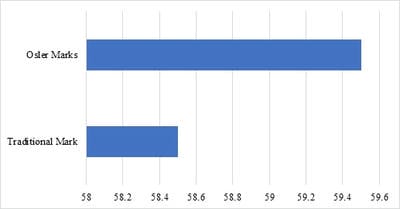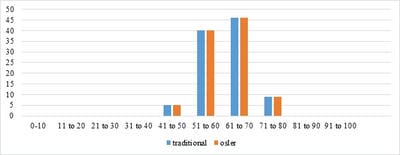Comparative study of conventional assessment and OSLER conducted at the model clinical examination in a teaching hospital
G Prabhu S.1, Abraham G.2*, Malavika Nair L.3
DOI: https://doi.org/10.17511/ijoso.2020.i03.03
1 Satish G Prabhu, Professor and Unit Chief, Department of General Surgery, MOSC Medical College, Kochi, Kerala, India.
2* George Abraham, Associate Professor, Department of General Surgery, MOSC Medical College, Kochi, Kerala, India.
3 Lakshmi Malavika Nair, Department of General Surgery, MOSC Medical College, Kochi, Kerala, India.
Background: Assessment of competency of the long case at the end of the clinical posting is quite often subjective and the assessment need not always be foolproof. In this method objectivity, validity and reliabilityare lacking. The major drawback of this system is that the student is not observed by the examiners. To avoid these criticisms the Osler has been developed. It is a 10 item analytical record of the traditional long case to improve the objectivity, validity, and reliability of the traditional method. All the candidates were assessed by theexaminer for the same ten items. Though not perfect, Osler is envisaged as a solution for the ongoing assessment challenge. This study was undertaken as part of the thesis for Advanced Course in Medical Education-2018. Objectives: Comparison betweenthe conventional method and the OSLER at long case clinical examination. Materials and Methods: This is an educational interventional study conducted by the department of general surgery, MOSCMedical CollegeKolenchery on students of the 8th semester. The students were assessed by two examiners based on a commonly agreed clinical examination format. Data on scores by both groups were analyzed statistically. Result: The marks showed a correlation between the two methods ofassessment. However, the grade awarded by the examiners showed lesser correlation. However, a multicentric study by different examiners may be required to arrive at the final conclusion of the superiority of OSLER over the traditional method. Conclusion: The present study did not find a statistically significant difference between the marks awarded to the student by the conventional method and OSLER method.
Keywords: OSLER, Conventional method, Clinical examination
| Corresponding Author | How to Cite this Article | To Browse |
|---|---|---|
| , Associate Professor, Department of General Surgery, MOSC Medical College, Kochi, Kerala, Indiaa. Email: |
Prabhu SG, Abraham G, Nair LM. Comparative study of conventional assessment and OSLER conducted at the model clinical examination in a teaching hospital. Surgical Review Int J Surg Trauma Orthoped. 2020;6(3):154-158. Available From https://surgical.medresearch.in/index.php/ijoso/article/view/178 |


 ©
© 
